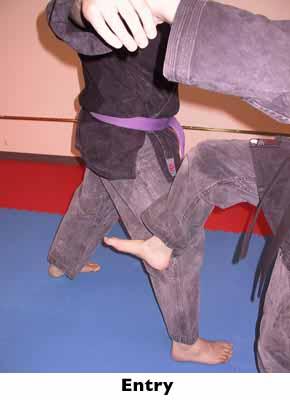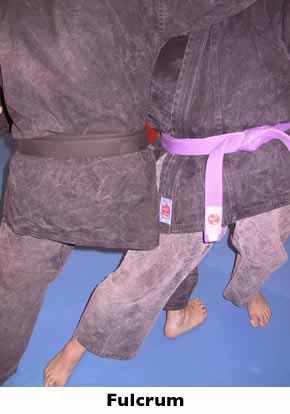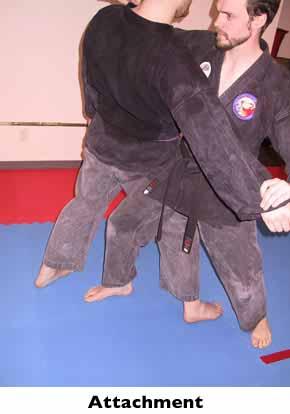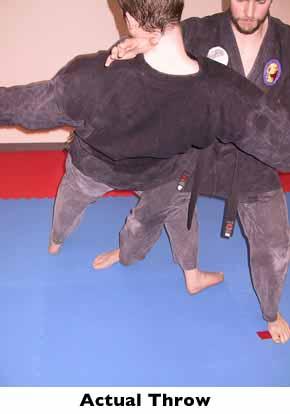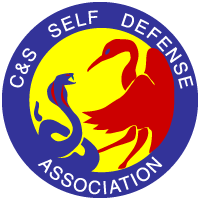
|
C&S Online
An Online Newsletter For The
C&S Self Defense Association
Spring 2004
Confidence. Fitness. Success.
|
|
Featured Articles...
|
Counting Coup
Grandmaster Peter Rose
Rose School of Karate, Portsmouth, NH
 I'd like to share with you something that we do at the Rose School of Karate called "counting coup" Counting coup was an American Plains Indian custom of showing bravery in the face of death. The brave would stake himself out in open ground (i.e. tie a length of rope from one of his ankles to a stake in the ground) and wait for his enemies to attack. As his enemies came at him, rather than spearing them or otherwise defending himself, he would rather simply avoid the attack and touch the enemy. This touch was called a "coup" and the more successful coup the brave could make (i.e. "count"), the more esteem he commanded in his tribe. It was a great honor to boast of the number of successful coup one could thus claim.
I'd like to share with you something that we do at the Rose School of Karate called "counting coup" Counting coup was an American Plains Indian custom of showing bravery in the face of death. The brave would stake himself out in open ground (i.e. tie a length of rope from one of his ankles to a stake in the ground) and wait for his enemies to attack. As his enemies came at him, rather than spearing them or otherwise defending himself, he would rather simply avoid the attack and touch the enemy. This touch was called a "coup" and the more successful coup the brave could make (i.e. "count"), the more esteem he commanded in his tribe. It was a great honor to boast of the number of successful coup one could thus claim.
The following words are from Plenty-coups, Chief of the Crows in 1848:
"
In you, as in all men, are natural powers. You have a will. Learn to use it. Make it work for you. Sharpen your senses as you sharpen your knife. Remember the wolf smells better than you do because he has learned to depend on his nose. It tells him every secret the winds carry because he uses it all the time, makes it work for him. We can give you nothing. You already poses everything necessary to become great. Use your powers. Make them work for you, and you will become a chief.
"
Courageous advice from a true warrior. At the Rose School, we combine Chi-Sau with Counting Coup in a more combative form of Chi-Sau than some of you may be familiar with. We do this because we rarely spar; we find sparing counter productive to learning street self defense. Besides, sparing is a young person's game and many of our students (and yes — many of us instructors!) are a little long in the tooth to be scrambling around sparing for fun anymore.
Traditional Chi-Sau focuses around constant "engagement" (the topic of my last article in the October 2003 Edition of C&S Online, Beginning Chi-Sau) of the two practitioners. When one senses a balance or positional advantage over the other, they then try to push or pull the other person off balance.
We add the Counting Coup component to this process. In addition to the off balancing attacks, we try to "touch" the other persons body thus establishing a "coup". At the more advanced levels, this "touch" becomes quite aggressive.
Our purpose in Counting Coup is two fold. First, for the person making coup, this is a validation of their control over their rooting, Chi flow, and aggressive mind set. Second, for the person having a flurry of coup done against them, it requires warrior spirit to go on in the face of overpowering adversity; one must put away their ego and remain calm looking for the opportunity to turn the tide and begin making their own coup.
In sparing, one can brush off the loss of a point as a "lucky" tag, but not so in Chi-Sau. When coup is made on you it is because you have lost focus; you have no one to blame but yourself. It is an eye opening and gut wrenching drill, and one in which my students take great delight in trying to reduce their opponent to a crying fetal position wallowing on the deck.
A third purpose in practicing Counting Coup is in preparation for the student to be able to respond to a surprise attack with a flurry of making coup distractions at the attacker until an opening is created so that a sound and powerful response can begin. The process of making coup is very much in line with my overall philosophy of focusing on "reactive self defense". Very infrequently will you be in a position where you know you are going to be attacked; the attack will just happen and you must immediately respond. You cannot afford to "figure out" what your response will be; there is not enough time. So, you immediately go into action — you take the initiative by engaging the opponent by making coup. An interesting example of the use of this theory can be seen in the first fight scene that Tommy Lee Jones has in the movie "The Hunted" (2003). The Chi-Sau drill incorporating Counting Coup is a great educational tool for this type of training.
Grandmaster Peter M. Rose holds an 8th Degree Black Belt. He began his studies with Grandmaster S.A. Brock in 1968. He has operated the Rose School of Karate in Portsmouth, NH since 1972. Grandmaster Rose is a senior software engineer, analyst, designer, and technical project manager. Grandmaster Rose can be reached at zzrose@yahoo.com, or you can visit his personal web site http://www.zzrose.com/pmr.html.
Top | Front Page | Board | Featured | Happenings | Views | Back Page | C&S Home
|
The Warrior Spirit
Master Bruce Vinciguerra, 5th Degree Black Belt
Somersworth School of Self Defense, Somersworth, NH
 How many times have you heard your teacher talk about the warrior spirit? Do you know what the warrior spirit is? Before going any further, take a few minutes and write down your thoughts on what you think the warrior spirit is and why it is so important.
How many times have you heard your teacher talk about the warrior spirit? Do you know what the warrior spirit is? Before going any further, take a few minutes and write down your thoughts on what you think the warrior spirit is and why it is so important.
Well — what do you think the warrior spirit is? Is it learning how to punch and kick so good that you can take on anyone? That is how many people think that view us from the outside. They have no idea how narrow a view this is, or of the benefits of the Art. As Martial Artists we all train to be a warrior and yet many times it is hard to see how that fits in with our modern lives. Sure, we may have to physically defend ourselves at one time in our life; but statistically we will probably never have to. So what is the point of all this training if we will probably never have to defend ourselves? The point of our training is to develop and strengthen ones body as well as the mind so that we can defend ourselves against the enemy of a warrior: Cowardice.
Cowardice is not facing life and the challenges that it gives us. We all want to feel cozy and warm and safe. We all want to have control over life and do not like it when something pops up unexpectedly; but sometimes, when life challenges us, we are reminded of our mortality and frailties as human beings. We become afraid of losing the things that we have, whether it is a job, family member, friend, pet, home, etc. The problem with always worrying about what might happen is that we live in a constant state of fear. This constant state of fear, or cowardice, reduces our ability to celebrate and enjoy life. The Buddhists teach what is known as the four noble truths. The first noble truth is: Suffering exists
If we learn to accept this truth, then we do not have to be afraid of it. We can face it when called upon and not be fearful of it. This is being a warrior.
Our Art teaches us to look directly at ourselves and see the cowardice that we all have. The goal is to move beyond that cowardice and as the Masters say, "Look the Tiger in the Eye." By understanding your fears, your joys and the thoughts that motivate you to do the things you do, this enables you to take complete responsibility of your life. BST states that: "In order to become who you would like to become, you have to alter the way that you think." You will never be able to do this unless you accept that you are afraid, understand the person you are now and that you want to change.
This is the warrior spirit I am talking about. To be a warrior, one must walk with a strong spirit every day. So how do you get this spirit? Our Art has a process that brings us through stages that develop and strengthen our spirit. First, we train to become physically and mentally strong. When we realize that we can defend ourselves, then that sets us free from one of our biggest fears - the fear of being attacked or hurt. What this does is empower us and make us strong by cultivating the confidence that lies within all of us. Confidence is the essence of the warrior spirit, for without confidence we become paralyzed with fear and lose control over our lives. The warrior's confidence enables him to look into himself and see the fears and strengths that make up his spirit. This will free your spirit so that you can see life as exciting and challenging. You will have a sense of peace within you that everyone will sense.
So do we stop training when we feel this peace? No! We continue to train to remain strong and look deeper within ourselves. We share and help others by sharing this process so that they can find their peace. This is our goal.
5th Degree Black Belt Master Bruce Vinciguerra is the head instructor of the Somersworth School of Self Defense in Somersworth, NH. He is a Canemaster in the Cane Masters International Association. He owns Tony's Television where they specialize in the repairs of Video and Audio Equipment. He is married with 3 children and has been training in the Art since 1983.
Top | Front Page | Board | Featured | Happenings | Views | Back Page | C&S Home
|
Modified Hip Throw
Yondan Daniel Wilkewitz, 4th Degree Black Belt
Chung Fu-do, Fort Collins, CO
 One of my favorite takedowns is the basic hip throw. Done properly, it is almost always effective. Taught in the traditional manner in karate and judo, though, it has some significant problems.
One of my favorite takedowns is the basic hip throw. Done properly, it is almost always effective. Taught in the traditional manner in karate and judo, though, it has some significant problems.
The traditional instruction teaches the entry as the placement of one's hips behind the opponent to serve as a fulcrum that the opponent's upper body is then pushed over. If timing is perfect and the opponent's resistance is weak, the technique will work. But one substantial problem is that the entry and placement of the fulcrum creates a near equal position between oneself and the opponent allowing either to take advantage of the position and execute the throw. An opponent who is ready for the throw can take advantage of the position just as easily as the person initiating the throw. Hardly a confident technique to bet the farm on.
Additionally, the traditional instruction emphasizes "pushing" the upper body over the fulcrum and this almost always requires some degree of lifting the opponent over the fulcrum before they lose balance sufficiently to really push them over to the point of falling. It also exerts this force in a linear fashion against the direction the opponent finds the easiest to resist. This requires emphasis on strength and limits the effectiveness of the technique against larger opponents. As I am fond of saying, "There's no point in training to beat up smaller people."
For a number of years I have been perfecting a variation of the hip throw that creates a much more advantageous position of entry and relies on simple stance transition (center of mass based) to affect the throw instead of perfect timing and lifting with brute strength. The entry is where the magic begins. Rather than stepping around the opponents forward leg to position the hip fulcrum behind him, the step in is done down and through the opponent's leg by stepping down at a 45 degree angle into a forward stance (see ENTRY PHOTO). The step down entry "shaves" the opponent's thigh with your calf and then your thigh using the mechanical advantage of an inclined plane (thanks to Master Landers for this id). At the completion of the entry, you will be in a strong forward stance with a fully engaged fulcrum (see FULCRUM PHOTO) against an opponent whose center of mass has been shifted sufficiently to allow the rest of the throw to progress with little effort. It is this shift of your opponent's center of mass that separates this version of the hip throw most dramatically from the "get behind and throw him before he throws you" version.
After the correct entry places you in a strong position against your opponent (who is now unstablized), you simply lock your body to your opponent with your arms (see ATTACHMENT PHOTO) and then rotate your stance from the forward into a deeper straddle. Your unbalanced and attached opponent will fall (more of a slide) over the fulcrum of your hips, landing nicely in front of you with so little effort you will be amazed (see ACTUAL THROW PHOTO). Here are some hints on each part:
Keys to success on the entry
- Step through your opponent's leg enough to unbalance them and secure your position, but not so much that you get stuck in him. It's a similar concept to depth of penetration when punching a bag (or person). You have to penetrate a certain depth to get effect, but too much and you'll get stuck inside. The perfect entry will unbalance him while allowing you to maintain velocity for the rest of the throw.
- If you feel like you are running into a brick wall with the entry, try shifting your angle of attack further to the side. I find that an AOA of 30 to 60 degrees works the best.
- Maintain your momentum through the entry. You cannot "try" the entry. You must have conviction in your stepping. This is aided greatly by the 45 degree approach to the ground which utilizes not just your forward motion, but the powerful attraction of gravity.
Keys to success in the attachment
- Experiment with the length of the lever in where you place your arms on their upper body, but do not place them so high that they become disconnected from your center.
- Grab your opponent firmly and take up as much slack as possible between you. If your opponent is not one with you at the point of your center of mass change, they will not follow into the throw.
- Utilize your sense of chi sao as you grab. You want to meld with your opponent from the point of entry until he falls. This is as much of a sensation mentally as it is physically.
Keys to success in the actual throw
- Forget about your arms as generating any real force in the throw. The throw is driven by your change of body that occurs in the stance change from the forward into the deeper straddle. If you try to push too hard with your arms you will energetically detach them from your opponent and lose the connection to center.
- To achieve a deeper straddle, you must DROP your center. You cannot simply turn from a forward into a straddle on the same plane and expect your opponent to fall. Your center must drop to lead your attached opponent into the fall.
- Allow the whole motion of the throw to have a winding path. It is this motion outside of the opponent's power zone that makes it as easy as it is. The traditional throw pits your motion against the strongest angle
Stated as simply as possible, here are the 3 steps of the modified hip throw:
- Entry: From a front side angle of attack, step down at a 45 degree angle through your opponent's leg landing in a strong forward stance, unbalancing your opponent and establishing a connected fulcrum.
- Attachment: Grab your opponent firmly and integrate your center with him.
- Throw: Rotate your stance from forward into a deeper straddle, throwing your opponent over your hip.
I hope that this modification of the hip throw makes it a potent weapon in your arsenal. If you have any questions on execution, feel free to e-mail me at dan@fireridge.net. Thanks to the models, Sempai Chuck Fussman and Yonkyu Chad Anonson. (If interested, I have a QuickTime video of this series.)
4th Degree Black Belt Yondan Daniel Wilkewitz has been a student of Master Dusenbery's since 1984. He is head instructor of Chung Fu-do and makes his home in Fort Collins, Colorado with wife Robin, daughter Calin and son Taran. Professionally he owns a mortgage brokerage and a graphic design studio. Yondan Wilkewitz can be reached at dan@fireridge.net.
Top | Front Page | Board | Featured | Happenings | Views | Back Page | C&S Home
|
Website design by Peter Rose, zzrose@yahoo.com
|



 One of my favorite takedowns is the basic hip throw. Done properly, it is almost always effective. Taught in the traditional manner in karate and judo, though, it has some significant problems.
One of my favorite takedowns is the basic hip throw. Done properly, it is almost always effective. Taught in the traditional manner in karate and judo, though, it has some significant problems.
